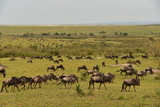
We saw an older “baby” nursing from its mother. This “baby” wildebeest was so old it had to kneel down on its front legs to get any milk. The mom looked quite put out by it.
14 October 2017 Saturday - Masai Mara ~ Day 5
Today was our last day in the Masai Mara. Our guides told us we would do another game drive on our way to the airport. I thought: Yeah, right, it’ll be a slow boring drive and we won’t see any animals. I was wrong.
Naturally, we saw lots and lots of wildebeests. Everywhere. Sometimes they’re in great herds. Other times it seems like they’re queued up a thousand long like a checkout at Walmart.

We
saw an older “baby” nursing from its mother. This “baby”
wildebeest was so old it had to kneel down on its front legs to get
any milk. The mom looked quite put out by it.
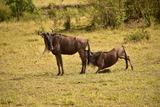
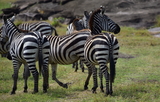
We
also saw zebras. Someone pointed out the fact that zebra’s tails
look like they’re braided like a pony tail.
We saw an eagle sitting atop a small tree.
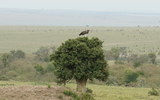
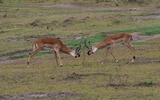
Next,
we saw a couple of young impalas sparring; practice-fighting for
later in life.
We saw some black-backed jackals playing and running around like foxes.
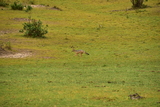
We
saw another one of those kori bustard birds.
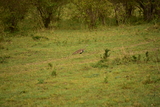
We
saw a little bee eater, which is a small, colorful bird. It was
carefully camouflaged so most of us had a hard time seeing it. I
remembered seeing lots of these in Botswana, but I hadn’t seen any
here until today.
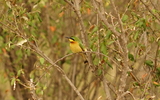
We
stopped by a hyena den where there were babies.
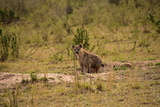
One
of the hyenas tried to get into an occupied den, and the female
occupant chased him away. He ran out of there in a big hurry.
Finally, he curled up in the dirt and lay down, looking dejected.
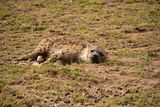
On
the way I got a good photo of him with his mouth open. Their jaws are
so powerful, they crush and eat bones. In fact, their poop comes out
white because of it.
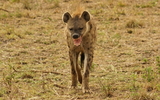
We
saw a bunch of impalas, which I also hadn’t seen many of since
Botswana. The male had beautiful horns.
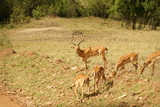
If
you read my travelogue from our Botswana trip, you may recall that
impalas are called the “McDonald’s” of the bush because if you
look at the markings on their tails, it looks like the McDonald’s
golden arches.
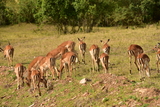
We
drove to a very scenic area of the Mara that was rocky. We saw a
couple female lions lying atop the rocks from a great distance.
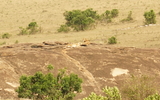
Our
guides drove us back around to the pride’s regional headquarters to
see if any other lions were hanging around. On the way, we saw a
couple vultures.
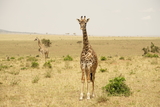
One
of the giraffes had a cute “little” baby that kept hiding behind
mom.
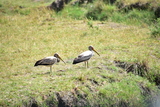
When
we got to the lion area, we hit the jackpot. There was a large pride
of lions, including several females, a large male, and some really
cute lion kittens.
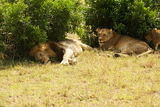
We
stayed and watched the lions for a very long time. It very cool and
we got some great photos.
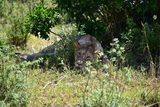
Eventually
we had to say goodbye to the lions and head to the airport. On the
way, we saw one last Reedbuck.
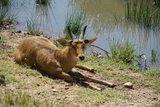
We
asked someone to take a group photo: From left to right: Big John,
Cheung, Moses, Mary, Stefan, Winnie, Bettan, George, Patty, Dan,
Judy, Kathy, Bob.
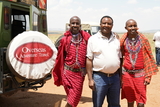
A
Maasai vendor and Kathy negotiating one last sale.
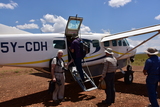
On
our way back to Nairobi, we got a better look at the windmills.
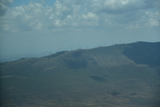
We
landed at the Wilson airport in Nairobi again, where we met our
Tanzania guide, Eki. Eki told us a bit about himself: He’s from the
Maru tribe and grew up at the base of nearby Mount Maru. He used to
be a guide for mountain climbing: He led expeditions to the top of
Mount Kilimanjaro, at least until he got to be too old. After that he
became a guide for OAT, and he’s been a guide for more than ten
years. And it showed: He was great in all respects.
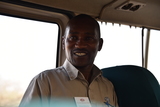
Then
we proceeded to drive from Nairobi to Tanzania.
Wait. I had to do a double-take. Did that gas station in Nairobi say “Astral”?

It
slays me some of the things you see when you travel. Like cows
walking around on the city streets.
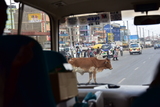
Like
women balancing lots of heavy things on their heads.

You
don’t need to be an old women to wear purple here. Take that, Red
Hat Society!
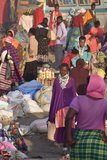
When
the chairman and CTO absolutely have to get to the board meeting on
time.
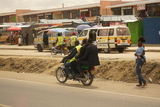
Here’s
how not
to get your baby across town:
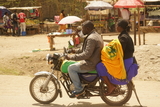
Here’s
how to transport hay to your cows:
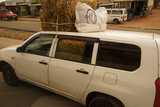
On
our way to Tanzania, we saw this really weird looking long-necked
antelope called a gerenuk.
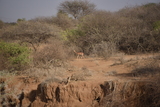
Eventually,
our bus made its way to the border crossing between Kenya and
Tanzania. The border crossing took a while: We had to be “checked
out” of Kenya and “checked in” to Tanzania. We had to scan our
fingerprints of all ten digits of both hands. Then we headed to
Arusha, Tanzania where we stayed at a beautiful plantation that was
once used to produce coffee. They still grow coffee, but now they
just supply their guests.
The beds all have mosquito netting around them, but I haven’t seen any mosquitoes yet.